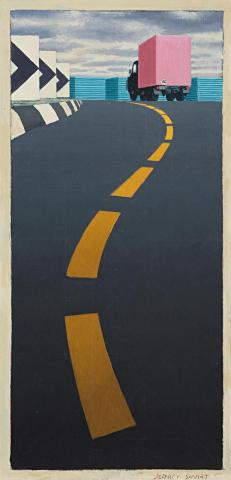THIRD STUDY FOR THE DIVIDING LINE, 1977-78
Jeffrey Smart
oil on canvas on board
49.5 x 25.5 cm
signed lower right: JEFFREY SMART
Australian Galleries, Melbourne
Private collection, Melbourne
Company collection, New South Wales
Private collection, Melbourne
Jeffrey Smart, Australian Galleries, Melbourne, 29 March – 11 April 1978, cat. 23 (label attached verso)
Quartermaine, P., Jeffery Smart, Gryphon Books, Melbourne, p. 115, cat. 700
McDonald, J., Jeffery Smart: paintings of the '70s and '80s, Craftsman House, Sydney, 1992, p. 152, cat. 162
The Dividing Line, 1977-78, oil and synthetic polymer paint on canvas, 100.0 x 46.0 cm
Encapsulating the artist's unerring instinct for the beauty of modern signs and symbols, 'The Dividing Line' paintings are arguably among the most widely recognised and acclaimed of Smart's achievements. Featuring the iconic motif of the lorry disappearing over the horizon, not only does the series directly relate to his celebrated Guiding Spheres (Homage to Cézanne), 1979, where the truck, guiding spheres and witches hats specifically reference Cézanne's famous injunction '...to see in nature the cylinder, the sphere and the cone.'1 But, perhaps more importantly, of Smart's entire oeuvre it was the final version of The Dividing Line, 1977-78, which the artist selected to illustrate the cover of his autobiography Not Quite Straight, 1996, - emblematic no doubt of his predilection for the unexpected and ironic in both art and life.
Like Cézanne, Smart's priority has always been the pursuit of the consummate composition - as articulated eloquently in his oft-quoted adage 'the subject matter is only the hinge that opens the door, the hook upon which one hangs the coat. My only concern is putting the right shapes in the right colours in the right places. It is always the geometry.'2 Affording a rare, intimate glimpse into the artist's creative thought process, the present study should nevertheless be considered independently as a work in its own right. For unlike compositions which betray a sense of evolvement, Smart's paintings always bear a remarkable quality of planned completion - usually aided by a single dominant feature, such as the pink lorry here which leads the viewer to a dramatic horizon and mysteries of an unseen vista beyond.
Arguably one of the great paradoxes of Smart's achievement is that symbols of modernity, pressure and activity such as the autostrada should be imbued with an aura of timeless serenity reminiscent of the classical compositions of Piero della Francesca. In stark contrast to his Renaissance predecessor, however, the element of stillness in Smart's work is decidedly more disturbing - perhaps because 'we still find it oddly beyond belief that practical and mundane familiarities like roads and railways should be elevated to the status of semi-mystic icons.'3 Thus focussing our attention on the formal qualities of his immaculate compositions such as Third Study for The Dividing Line, Smart encourages his audience to see the everyday with fresh eyes, to discern beauty in the most unromantic, unprepossessing of subjects. As Quartermaine reiterates, '...Smart's paintings are not tobe looked through but looked at. If we look through them, we find only the preconceptions we brought with us - by looking at them with the attention they demand we can experience their world.'4
1. Quartermaine, P., Jeffrey Smart, Gryphon Books, 1983, p. 33
2. ibid., p. 74
3. Capon, E., 'Still, Silent, Composed: The Art of Jeffrey Smart' in Jeffrey Smart Retrospective, Art Gallery of New South Wales, Sydney, 1999, p. 14
4. Quartermaine, op.cit., p. 78
VERONICA ANGELATOS
